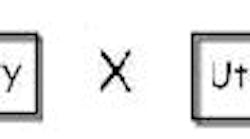The Maintenance Image
The word "maintenance" is typically associated with negative connotations. Whether the word makes one think of a broken machine or a repair need, it is clearly linked with negativity and pessimism. On the contrary, maintenance is defined as "the work of keeping something in proper condition; upkeep." Thus, maintenance is much more important than many people realize.
When examining the issue of maintenance, there are a number of questions to consider. How many senior managers come from maintenance? How many companies support maintenance R&D? How many interns are hired for the maintenance department? And how many maintenance courses do universities offer? The answer to all of these questions is very few. Essentially, it shows maintenance is at a very low priority for most organizations. Another consideration is that maintenance is usually the first department that companies cut when downsizing. Such a cut can seriously damage a company’s long-term survival.
Cost Center vs. Profit-Center Approach
In an effort to view maintenance as a positive activity, it is important to see it as a profit center instead of a cost center. A cost-center approach is strictly concerned with adhering to the budget and decreasing expenses as much as possible. In contrast, the profit-center model realizes that investment and operating costs can be allocated to improve efficiency. This increased efficiency naturally results in higher profits.
I have conducted numerous seminars on Computerized Maintenance Management Systems (CMMS). Based on responses from hundreds of attendees, I would guess that a majority (more than 90%) of the companies are operating their maintenance department as a cost center.
Importance of Maintenance
Maintenance is the backbone of any organization where equipment must be maintained; whether it is a manufacturing plant, a facility, or a utility company. If your production machine is down and you cannot deliver products or services, serious consequences can result. Some of the consequences for this include losing customers, money, and business. If you are dealing with a facility, equipment breakdown could mean poor service to other departments or customers resulting in loss of money. With a CMMS in place, maintenance can save time and money for a number of industries. Maintenance is obviously too important to ignore.
Turning Maintenance into a Profit Center
It is clear that companies must take a profit center approach to maintenance. There are numerous ways in which companies can turn maintenance into a profit center. One such way is through “product quality with zero error." Just as professional athletes must train to keep their bodies in excellent shape to be able to perform, this approach stresses keeping the machinery and facilities in the best possible condition. Thus, producing higher quality products will lead to a lower return rate. Typically profits will increase.
Another way that companies can turn maintenance into a profit center is through "Overall Equipment Effectiveness." OEE consists of three factors: Availability, Utilization, and Quality Rate. I will briefly define each of these:
Availability- The percentage of time that the machine is available for production.
Utilization- Essentially, it is the rating of the machine. The manufacturer provides the customer with a design specification rating for the machine.
Quality Rate- How good the final product is. Out of every 100 items produced, it is how many of them meet company standards of approval for distribution or sale.
In conclusion, maintenance is a very important activity that should be viewed as a profit center. While many companies simply view maintenance as an added expense (or a cost center) it should instead be thought of as an important investment in a company's future. There are also a number of benefits to a CMMS. The greatest of these are that it helps cope with downsizing and increases efficiency.
Kishan Bagadia, president of PEAK Industrial Solutions, has been involved in every aspect of CMMS for more than two decades. He’s published two books, two chapters and many technical articles on the subject. He can be reached at [email protected]
